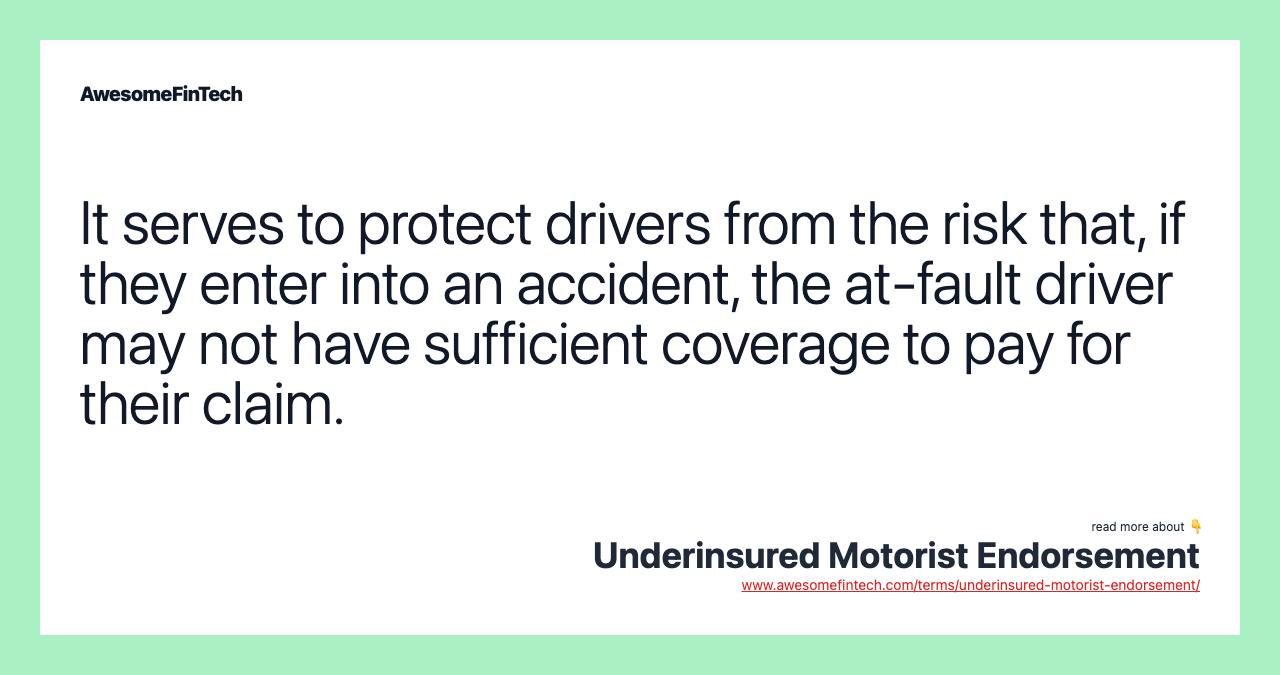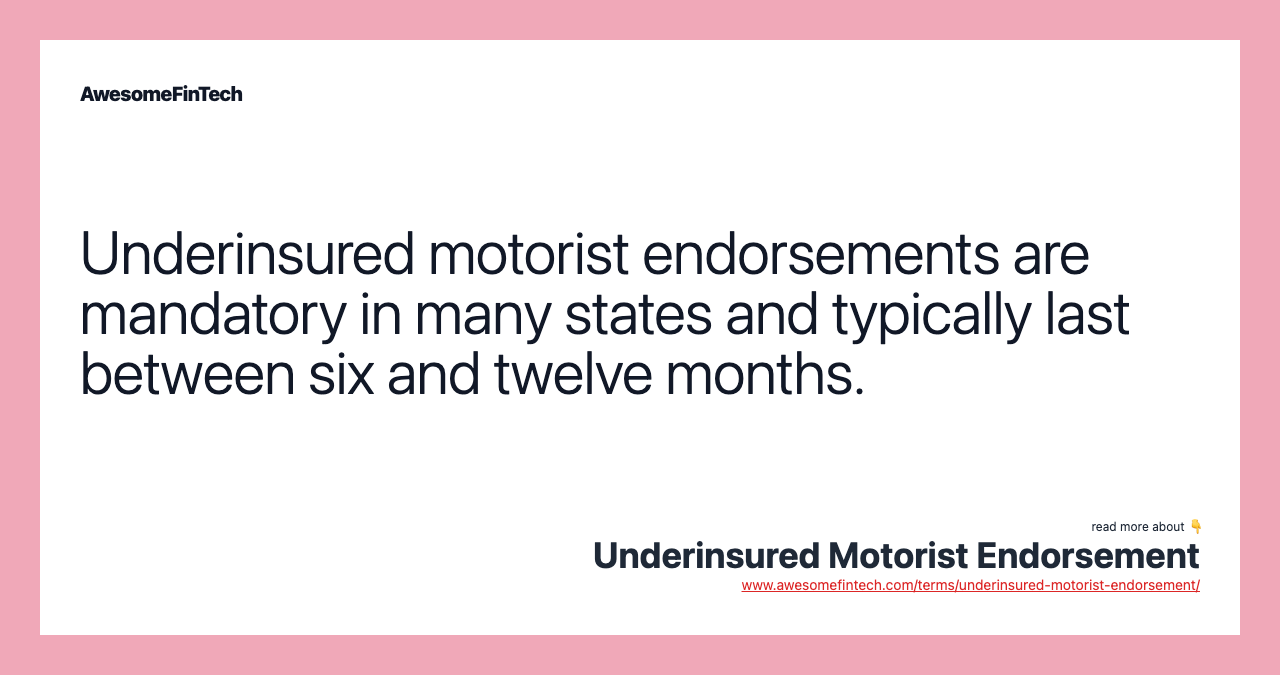Underinsured Motorist Endorsement
In the insurance industry, an underinsured motorist endorsement is a type of supplemental insurance commonly purchased as part of an automobile insurance policy. In the insurance industry, an underinsured motorist endorsement is a type of supplemental insurance commonly purchased as part of an automobile insurance policy. In a scenario where the at-fault driver has no insurance and no personal assets to pay for the claim, the endorsement would therefore cover the entire amount of the claim, up to the maximum coverage level specified in the policy. For this reason, Driver A’s insurance pays $100,000 out of the $175,000 total, whereas Driver B’s insurance pays the remaining balance of $75,000. Drivers purchase auto insurance for several reasons, such as the risk of their car becoming damaged in an accident, the risk of damaging another person’s car, or the risk of killing or injuring another person.

What Is an Underinsured Motorist Endorsement?
In the insurance industry, an underinsured motorist endorsement is a type of supplemental insurance commonly purchased as part of an automobile insurance policy. Its purpose is to provide additional coverage to the policyholder in the event of an accident resulting from another driver whose policy does not cover the total costs of the accident.



How Underinsured Motorist Endorsements Work
Drivers purchase auto insurance for several reasons, such as the risk of their car becoming damaged in an accident, the risk of damaging another person’s car, or the risk of killing or injuring another person. But one risk that is sometimes neglected by drivers is the possibility that they might be injured, or have their car damaged, by another driver who has failed to take out adequate auto insurance.
In that instance, the policyholder might have a legitimate claim against the at-fault driver but be unable to collect damages. After all, if the at-fault driver does not have the necessary assets or insurance, they might simply declare bankruptcy, leaving little or nothing for the victim to collect.
To protect against this risk, drivers can purchase underinsured motorist endorsements as part of their auto insurance policy. This supplemental insurance policy covers property damages, bodily injury to the policyholder, as well as injuries to insured family members or passengers. If a claim needs to be filed, the endorsement can cover the difference between the coverage paid by the at-fault driver’s insurance and the full amount owing.
In a scenario where the at-fault driver has no insurance and no personal assets to pay for the claim, the endorsement would therefore cover the entire amount of the claim, up to the maximum coverage level specified in the policy.
In many states, drivers are required by law to purchase underinsured motorist endorsements, although it is sometimes referred to using different terms. In some cases, this coverage only applies when the at-fault driver has no auto insurance at all, as opposed to covering the gap between their coverage and the claim amount.
Although the precise insurance requirements vary from state to state, they typically last from six to twelve months and are renewable thereafter. As with most insurance policies, the insurance premiums associated with the coverage will vary based on factors such as the policyholder’s age, years of driving history, and history of claims.
Real-World Example of an Underinsured Motorist Endorsement
To illustrate, consider a situation where Driver A gets into an accident with Driver B. The at-fault driver in this scenario is Driver A, and the full damages associated with the incident amount to $175,000. Unfortunately, Driver A only has $100,000 of coverage, but thankfully Driver B has an underinsured motorist endorsement.
For this reason, Driver A’s insurance pays $100,000 out of the $175,000 total, whereas Driver B’s insurance pays the remaining balance of $75,000. Because Driver B purchased an underinsured motorist endorsement, he is able to receive the full $175,000 and be made whole.
Related terms:
Auto Insurance
Auto insurance is purchased by vehicle owners to mitigate costs associated with getting into an auto accident. Discover more about it here. read more
Liability Car Insurance
Liability car insurance provides financial protection for drivers who harm someone else or their property while operating a vehicle. read more
Bankruptcy
Bankruptcy is a legal proceeding for people or businesses that are unable to repay their outstanding debts. read more
Endorsement
An endorsement is an amendment to a document or contract, an authorizing signature, or a public declaration of support. read more
Insurance Premium
An insurance premium is the amount of money an individual or business pays for an insurance policy. read more
Subrogation
Subrogation is the right of an insurer to pursue the party that caused the loss to the insured in an attempt to recover funds paid in the claim. read more
Third-Party Insurance
Third-party insurance, the most common example being auto insurance, is a policy designed to protect against the actions or claims of a third party. read more
Underinsured Motorist Coverage Limits Trigger
Underinsured Motorist Coverage Limits Trigger can be specified by an insured party to protect against losses caused by an accident with a driver who has insufficient insurance. read more
Underinsured Motorist Coverage
Underinsured motorist coverage is an auto insurance policy provision for property and bodily damage caused by a driver with insufficient insurance. read more
Uninsured Motorist Coverage (UM)
Uninsured motorist (UM) coverage may pay a policyholder's damages when an accident involves a driver who does not have insurance or is a hit-and-run. read more